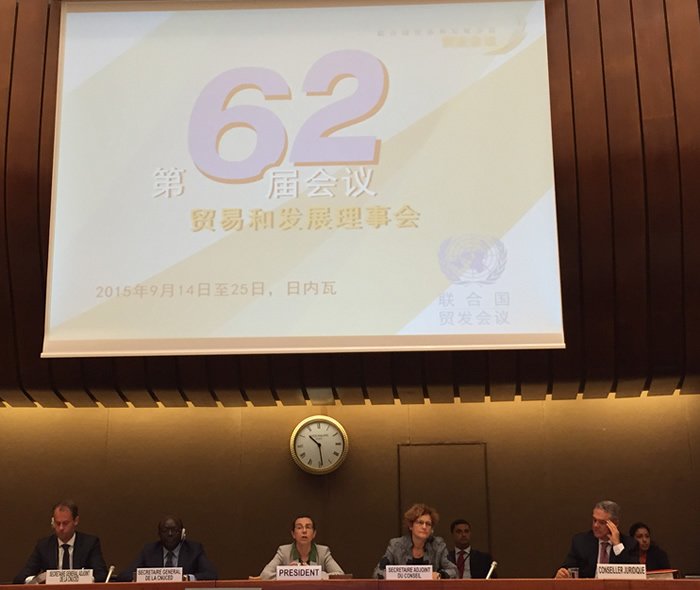Dr. Mukhisa Kituyi unveils his report to the fourteenth session of the United Nations Conference on Trade and Development (UNCTAD XIV) — the first United Nations ministerial conference of the post-2015 era.
As governments across the globe prepare to adopt 17 ambitious Sustainable Development Goals, UNCTAD Secretary-General Mukhisa Kituyi presented to United Nations member States in Geneva his report to the fourteenth United Nations Conference on Trade and Development (UNCTAD XIV).
This event will be "the first UN ministerial conference of the post-2015 era," Dr Kituyi said. As such "it will represent a starting point to translate the heightened ambitions of the international community into concrete plans of action".
Called "From Decisions to Actions", the report builds on lessons learned from impressive developmental advances in past decades and proposes detailed courses of action that tackle aspirations as yet unmet in order to deliver sustainable prosperity for all within the 15-year lifespan of the new Sustainable Development Goals.

"The last 25 years have set the stage for the final push in the eradication of extreme poverty within a generation," Dr. Kituyi said. "They taught us that we can expand the boundaries of what we think is possible."
Indeed, 1 billion people have been lifted out of extreme poverty in 20 years, the proportion of people living in destitution has been halved, hundreds of millions have joined the middle class, and a number of developing countries have become major engines of growth both for their region and the global economy.
Despite “the tremendous progress achieved," Dr. Kituyi said, "poverty and inequality, both between and within nations, remain a pervasive challenge". In the face of this, Dr. Kituyi said, the new global consensus on the Sustainable Development Goals "raises the bar and demands unprecedented actions and efforts”.
Achieving the Sustainable Development Goals will require resource mobilization on an unparalleled scale, he added. "Developing countries alone will need to invest $ 3.3 to 4.5 trillion per year in basic infrastructure, food security, climate change mitigation and adaptation, health and education," leaving "a gap of $2.5 trillion annually in real terms".
This also presupposes enhanced accountability, policy coherence and a stronger enabling environment at all levels, the report says, which puts forward a robust set of "action lines" to be followed by governments. These should form the basis for UNCTAD's mandate and the way in which the institution will shoulder its responsibility in supporting and complementing the efforts of the international community.
The "action lines" detailed in the report are grouped into four broad policy areas:
- Building productive capacity to transform economies
- More effective States and more efficient markets
- Tackling vulnerabilities and building resilience
- Strengthening multilateralism and finding common solutions
|
FROM DECISIONS TO ACTIONS: BACKGROUND
A growing number of developing countries and countries transitioning to market economies have joined the world economy – boosting international trade from 9.4 per cent of global GDP in 1970 to 24.4 per cent in 2014, with exports from developing countries accounting for half the world total. Developing countries are not only the chief recipients of foreign direct investment (FDI) whose global flows reached US$1.2 trillion last year, but a growing source of FDI accounting for over one-third of total global outward FDI, while Asia recently became the largest investor in the world. Between 2003 and 2013, Africa doubled its services export, Latin America almost tripled and Asia more than tripled. Between 2000 and 2011, internet usage in Africa grew by 2,500 per cent (global usage grew 480 per cent) and mobile phones usage grew 12 times in developing countries (as against 2.5 times in rich countries) which now have 91 mobile subscriptions per 100 inhabitants. Notwithstanding the halving of the world population living in extreme poverty, as achieved under the 2000–2015 Millennium Development Goals, more than 1 billion lived on less than US$1.25 per day and 10 per cent experienced chronic hunger in 2011. Action to narrow gaps in inequality and prosperity collide with the reality of the world after the 2008 financial and economic crisis. Trade is now growing at a slower rate than global output, the recovery of global foreign direct investment remains bumpy, and financial instability as well as economic volatility pose a threat to the improvements in prosperity that have been so far achieved. Large, speculative capital flows put at risk the debt sustainability and macroeconomic stability of many developing countries. This is compounded by extreme weather events and climate change, as well as challenges to peace and security arising from conflicts and terrorism. Putting the scale of the remaining challenge in perspective, the level of extreme poverty in China in 1994 was at, 46 per cent, about the same as the current level in least developed countries. In the fifteen years up to 2009 China had an annual per capita GDP growth of 9.4 per cent but was only able to reduce extreme poverty to 11.8 per cent. It follows that to eradicate extreme poverty, least developed countries will in the next fifteen needs to grow at a rate greater than China did during its boom years. |
|
FROM DECISIONS TO ACTIONS: FOUR ‘ACTION LINES’
|



